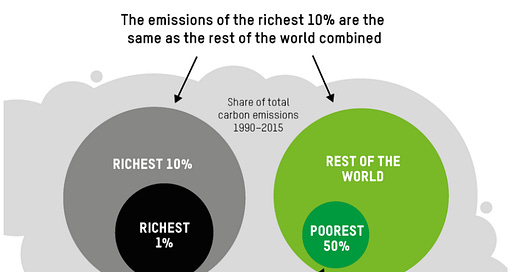The debate around climate change and thereby carbon emissions is mainly framed in a way that presents human race as a collective entity that exploited the environment around it with impunity and without realizing its consequences (Anthropocene) and now we have reached this stage where time is running out and the evident need to reduce carbon emissions becomes instantaneously relevant. The reality, however, is different. To say that human beings collectively were responsible for the environmental degradation is not factually correct. The industrialized or developed world is responsible for majority of the emissions when compared to the developing or emerging countries.
United States and China together account for about 44 percent of CO2 emissions. China leads the way as it accounts for 30 percent of global CO2 emissions however, on a per capita basis U.S. leads the way. U.S. has also emitted more cumulative emissions as compared to China over the past three centuries. The discrepancy between the emissions by richest and poorest, developed and undeveloped, is glaring. Look at the graph below: it shows energy usage per person. The difference between Canada, U.S. and Pakistan, Nigeria is appaling!
This has been highlighted multiple times via various reports. There was a recent one released by U.N. that mentioned that the wealthiest need to cut down their emissions by 97 percent to control the ongoing climate crisis as the top 1 percent of people globally (70 million people) emits 15 percent of global emissions, “more than what 3.5 billion people in bottom 50 percent.”
Another brilliant report by Oxfam, titled Carbon Inequality 2030, highlights the gaping gap between the richest and poorest in terms of emissions. It states the emissions by top 1 percent of the world will be 30 times higher on a per capita basis than what is compatible with achieving the goal of 1.5⁰C by 2030. This can create a huge vaccum of NDCs (Nationally Determined Contributions) to the tune of 2.2t CO2/capita. Furthermore, as per the report, the emissions by 80 million people i.e. richest 1 percent will still be 25 times higher as compared to 1990 even by 2030. As aforesaid, while there is need of reduction of 97 percent emissions in case of richest 1 percent, they will only be able to cut 5 percent by 2030. Lastly, and most importantly, the geography of emissions will also change as China, India and other middle income countries would end up contributing substantially more.
There are multiple threads or sub themes that one can go into from here such as: Argument of degrowth that only makes more sense after learning about the highly skewed distribution of carbon emissions. Also, the fact that as middle income countries emit more CO2, which they naturally would as countries set to increase their living standards, how can this be measured against the fact that we are against the clock and have already exhausted our Carbon Budget. However, we will resist that temptation and save it for future articles.
The point here is to highlight the fact that we might be framing the problem the wrong way. It isn’t the world as a whole that needs to direly cut down its emissions but certain countries and certain classes/sectors/industries within those countries. While COP26 and such exercises are essential to build narrative and call for action, we need action itself that too in the right direction. Clearly, we need a tailored solution, one that accounts for all of these discrepancies and inequalities. Is Degrowth that solution? We can’t be certain. But Negative Emission Technologies such as DAC (Direct Air Capture), CCS (Carbon Capture and Storage), renewable systems, and COPs only are not going to work at all.





